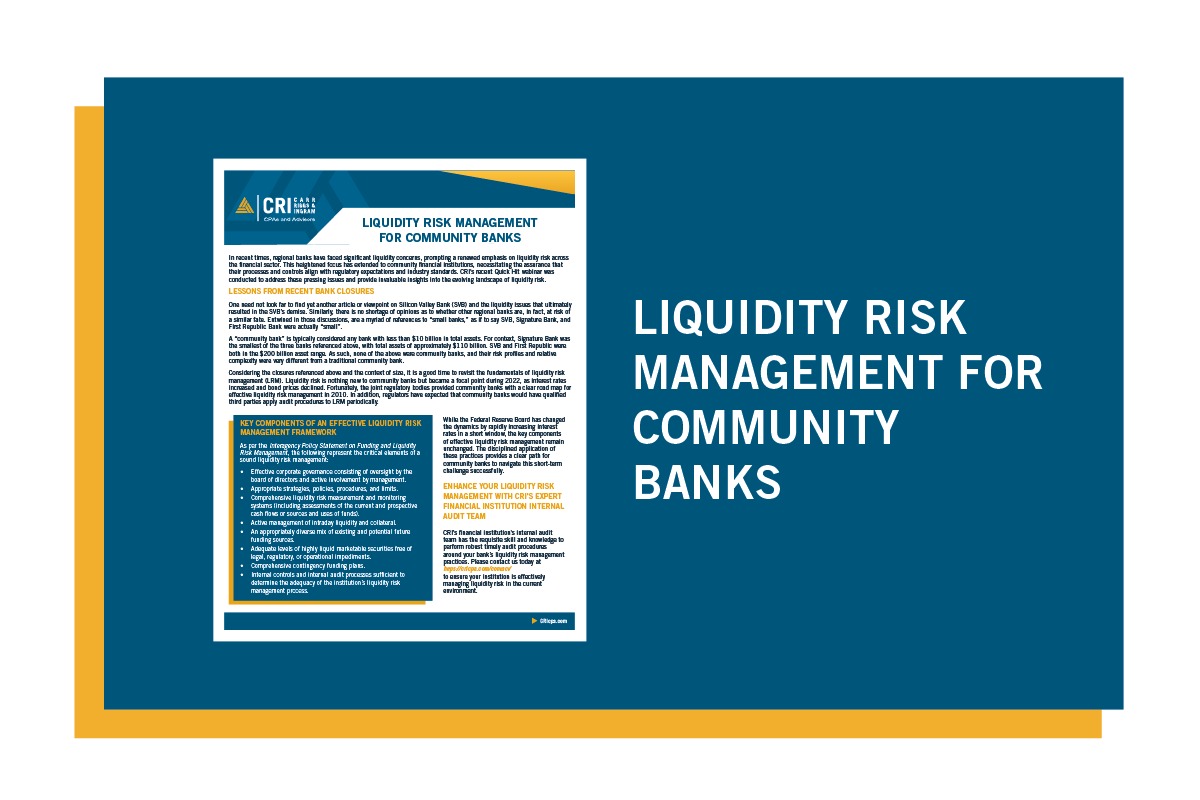Home>Finance>How Does Market Liquidity Impact Financial Managers?


Finance
How Does Market Liquidity Impact Financial Managers?
Published: February 23, 2024
Discover the crucial role of market liquidity in finance and its impact on financial managers. Learn how to navigate and optimize liquidity for financial success.
(Many of the links in this article redirect to a specific reviewed product. Your purchase of these products through affiliate links helps to generate commission for LiveWell, at no extra cost. Learn more)
Table of Contents
Introduction
Market liquidity is a fundamental concept in the world of finance, playing a pivotal role in the day-to-day operations of financial managers. It refers to the ease with which an asset can be bought or sold in the market without causing a significant change in its price. In other words, it measures the level of activity in a market, indicating the degree to which an asset can be converted into cash swiftly and with minimal impact on its price.
For financial managers, market liquidity is a critical consideration that directly influences their decision-making processes. The ability to buy and sell assets efficiently is essential for maintaining the financial health and stability of an organization. This is particularly true for businesses that rely on a diverse portfolio of investments, as well as for those involved in managing the financial assets of others, such as investment firms and financial institutions.
In this article, we will delve into the intricacies of market liquidity and explore its impact on financial managers. By understanding the significance of market liquidity and the strategies employed to manage it effectively, financial managers can navigate the complexities of the financial landscape with confidence and foresight. Let's embark on this journey to unravel the profound influence of market liquidity on the realm of finance.
Understanding Market Liquidity
Market liquidity is a reflection of the ease with which assets can be bought or sold in the market without significantly affecting their prices. This concept is a cornerstone of financial markets and is influenced by various factors, including the volume of trading activity, the number of market participants, and the depth of the market.
One of the key indicators of market liquidity is the bid-ask spread, which represents the difference between the highest price that a buyer is willing to pay for an asset (the bid price) and the lowest price at which a seller is willing to part with it (the ask price). A narrow bid-ask spread indicates high liquidity, as there is minimal disparity between buying and selling prices. Conversely, a wide spread suggests lower liquidity, making it more challenging to execute trades without affecting the asset’s price.
Another crucial aspect of market liquidity is the concept of market depth, which refers to the volume of buy and sell orders available at different price levels. Deeper markets have a higher number of orders at various price points, providing greater liquidity and reducing the impact of large trades on asset prices. This depth is essential for ensuring that assets can be traded without causing significant price fluctuations, thereby facilitating efficient market operations.
Furthermore, the level of market participation and the presence of active buyers and sellers contribute to overall liquidity. A market with a diverse range of participants, including institutional investors, retail traders, and market makers, tends to exhibit higher liquidity due to the increased likelihood of matching buy and sell orders swiftly.
Understanding market liquidity involves recognizing the interplay of these factors and their implications for financial managers. By grasping the dynamics of liquidity, financial managers can make informed decisions regarding asset allocation, risk management, and the execution of investment strategies, ultimately optimizing the performance of their portfolios and enhancing their ability to meet financial objectives.
Impact of Market Liquidity on Financial Managers
Market liquidity exerts a profound impact on the decision-making processes and operational efficiency of financial managers. The level of liquidity in the markets directly influences the ease with which financial managers can buy and sell assets, manage risk, and optimize portfolio performance. Understanding the implications of market liquidity is crucial for navigating the complexities of financial management effectively.
One of the primary effects of market liquidity on financial managers is its influence on transaction costs. In less liquid markets, executing large trades can lead to significant price movements, resulting in higher transaction costs for financial managers. Conversely, in highly liquid markets, the impact of large trades on asset prices is minimized, enabling financial managers to execute transactions more efficiently and at lower costs.
Moreover, market liquidity affects the ability of financial managers to adjust their investment positions swiftly. In times of market volatility or changing economic conditions, the ease of buying or selling assets becomes pivotal. High market liquidity allows financial managers to respond promptly to market developments, implement investment strategies effectively, and capitalize on emerging opportunities.
Additionally, market liquidity plays a crucial role in risk management for financial managers. In a liquid market, the ability to exit positions rapidly provides a layer of protection against adverse price movements. This flexibility empowers financial managers to mitigate potential losses and uphold the stability of their portfolios, enhancing their risk management capabilities.
Furthermore, the impact of market liquidity extends to the valuation of assets and the overall performance of investment portfolios. In less liquid markets, accurately valuing assets can be challenging, potentially leading to discrepancies in portfolio performance measurement. Conversely, in highly liquid markets, asset prices are more reflective of their true value, enabling financial managers to assess portfolio performance with greater precision.
Ultimately, the impact of market liquidity on financial managers underscores the significance of actively monitoring and managing liquidity risk. By comprehending the implications of market liquidity on their decision-making processes, financial managers can devise effective strategies to optimize portfolio liquidity, minimize transaction costs, and navigate market dynamics with agility and foresight.
Strategies for Managing Market Liquidity
Effective management of market liquidity is essential for financial managers to navigate the dynamic landscape of financial markets and optimize the performance of investment portfolios. By employing strategic approaches to address liquidity challenges, financial managers can enhance their ability to execute trades efficiently, manage risk, and capitalize on market opportunities.
1. Diversification: Diversifying investment portfolios across different asset classes and markets can contribute to maintaining liquidity. By spreading investments across a variety of assets, financial managers can mitigate the impact of liquidity constraints in specific markets, enhancing overall portfolio liquidity.
2. Utilizing Liquid Instruments: Emphasizing investments in liquid instruments, such as actively traded stocks and highly liquid bonds, can bolster portfolio liquidity. These assets can be bought and sold with ease, providing financial managers with the flexibility to adjust their investment positions swiftly.
3. Building Cash Reserves: Maintaining adequate cash reserves within investment portfolios can serve as a buffer against liquidity challenges. Having readily available cash enables financial managers to capitalize on investment opportunities and meet liquidity needs without being forced to sell assets under unfavorable market conditions.
4. Accessing Lines of Credit: Establishing access to lines of credit can provide financial managers with an additional source of liquidity when needed. This strategic approach allows for the swift deployment of capital to seize opportunities or address short-term liquidity requirements without disrupting investment positions.
5. Active Monitoring and Stress Testing: Continuously monitoring market liquidity and conducting stress tests to assess the impact of liquidity shocks on investment portfolios is crucial. By proactively identifying potential liquidity challenges, financial managers can develop contingency plans and adjust their investment strategies to mitigate adverse effects.
6. Establishing Relationships with Market Makers: Cultivating relationships with market makers and liquidity providers can enhance access to liquidity, particularly in less liquid markets. These relationships can facilitate efficient execution of trades and provide valuable insights into market dynamics and liquidity conditions.
7. Utilizing Derivatives for Hedging: Employing derivatives, such as options and futures, for hedging purposes can help financial managers manage liquidity risk. These instruments enable the mitigation of potential liquidity constraints by providing alternative avenues for adjusting investment exposures and managing portfolio risk.
By integrating these strategic approaches into their operational framework, financial managers can proactively address liquidity challenges, optimize portfolio liquidity, and position themselves to capitalize on market opportunities while effectively managing liquidity risk.
Conclusion
Market liquidity stands as a cornerstone of financial markets, exerting a profound impact on the decision-making processes and operational efficiency of financial managers. The ability to buy and sell assets swiftly and with minimal price impact is essential for optimizing portfolio performance, managing risk, and capitalizing on market opportunities.
Understanding the dynamics of market liquidity empowers financial managers to navigate the complexities of financial markets with agility and foresight. By comprehending the implications of market liquidity, financial managers can develop strategic approaches to effectively manage liquidity challenges and enhance portfolio liquidity.
From diversifying investment portfolios and emphasizing liquid instruments to actively monitoring liquidity conditions and establishing relationships with liquidity providers, financial managers have an array of strategies at their disposal to address liquidity concerns and optimize portfolio liquidity. These strategic approaches enable financial managers to navigate market dynamics, mitigate liquidity risk, and capitalize on emerging opportunities, ultimately contributing to the overall financial health and stability of their organizations.
As financial managers continue to adapt to evolving market conditions and navigate the intricacies of liquidity management, the ability to proactively address liquidity challenges and optimize portfolio liquidity remains paramount. By integrating strategic liquidity management practices into their operational framework, financial managers can position themselves to effectively manage liquidity risk and enhance their capacity to achieve their financial objectives in an ever-changing financial landscape.
In conclusion, the profound influence of market liquidity on financial managers underscores the imperative of actively managing liquidity risk and optimizing portfolio liquidity. By leveraging strategic approaches and maintaining a nuanced understanding of market liquidity, financial managers can navigate the complexities of financial markets with confidence, resilience, and a strategic vision for sustained success.














